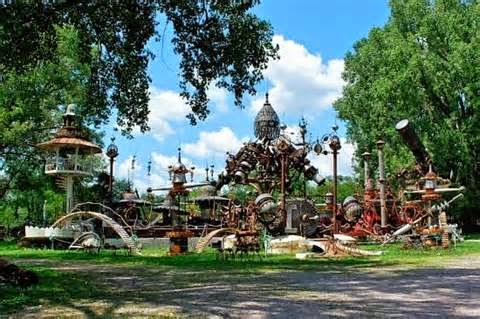By the team at RoadsideAmerica.com
North Freedom, Wisconsin
Dr. Evermor merrily manipulates bits and pieces of the
historical slipstream. He's been constructing God knows what behind
Delaney's Surplus since 1983.
Dr. Evermor is occasionally known
as Tom Every, a scrap artisan who owns a local salvage and dismantling
business. He's built the
World's Largest Sculpture on a
science fiction landscape, from old carburetors and discarded power
house machines -- like Japanese RPG weaponry from the Age of Steam. Oft
imitated by "Visionary Art"-wannabes, none have seriously challenged the
Doctor's ingenious conglomeration.
From the highway, the top of the 320-ton
Forevertron
is barely visible, its trans-temporal egg chamber poking up above the
foliage. A few devices, fanciful Victorian howitzers and strange
extrusions, sit along the roadside -- no signs or other warning of what
lies beyond.
You walk behind the surplus store into a
spider-silent alien carnival. Dozens of mechanical creatures, ranging
from waist-high to 20+-feet tall, flock in clearings. Disintegration
chambers, spaceship gun turrets, and huge insectoid contraptions are
obliquely arrayed. There are no labels or explanations, so you'll need
to talk to Dr. Evermor himself. We missed him during our first visit
years ago...
We're in luck this trip: Dr. Evermor greets us in his trademark pith helmet, cigar in hand.
His greatest achievement is the
Forevertron,
"designed and built in a timeframe of around 1890 ... whereas our dear
doctor is a scholarly professor who thought he could perpetuate himself
through the heavens on a magnetic lightning force beam inside a glass
ball inside a copper egg. You have to understand that at the time
electricity and magnetic forces were not fully understood." Tom's
anachronistic third person patter is critical to grasping how the
Forevertron operates.
"This device is called the
Graviton. The doctor would have to stand in that to
de-water
himself, to get his weight down, before going up that spiral staircase,
going across the little bridge, and getting into the glass ball inside
the copper egg."
We are treated to a walking tour around the base
of the Forevertron. "Everything here correlates to making the trip."
Tom waves his cigar towards a gazebo that sits atop a metal tower.
"Royalty would sit in the Teahouse for a commanding view. Doubting
Thomases look through the telescope to see if the Doctor made it. Two
people sit in the Doctor's
Celestial Listening Ears
over there and listen to voices from the heavens. At night they would
measure astrological bearing points, and transfer that information to
Overlord Control, which I'm building right over there..."
The structures perch on weathered concrete, the grounds of a long
ago demolished schoolhouse, a level stage for the freestanding metal
modules of copper and steel.
"On the other side we're building a
Juicer Bug to give us extra juice. The eyes are made from survey markers."
Tom
points out significant items welded into the main contraption. "The
Forevertron is built from important historical material, including those
dynamos, which were constructed by [Thomas] Edison around 1882 -- they
come from the
Ford Museum. And this unit was the
decontamination chamber from the Apollo space mission. A lot of the rest is from power houses from the 1920s."
Hold
on -- that's lunar decontamination salvage? "The Apollo decontamination
chamber was in three trailers [donated to a university]. We wrecked and
scrapped most of it, but I kept the two autoclaves that the moon rocks
were passed through." Tom is pretty proud to have this neglected piece
of America's space program. "We contacted NASA to try to get papers
authenticating it, and boy -- they're very touchy about what happened to
that stuff. We did get the original drawings and it's the same damn
thing."
While the Forevertron is huge, imposing, much of Tom's work is delicate and whimsical. The 70 members of the
Bird Band are lithe percussive instruments or tall string instruments.
"I'm
about the only guy that's using preexisting shapes and forms where they
lose their original identity and become something else, without any
alterations to that shape or form."
Tom doesn't use blueprints or
drawings, and has no traditional art schooling. "No sketches, no
models, no nothing -- I just go for it." This is pretty amazing, since
sculptures like the Juicer Bug are fifteen tons, and will be hoisted up
on spindly insect legs. "Everything here is free floating. I got these
bug toenails up in the air, but I don't want a toenail falling off on
somebody." He develops his own construction solutions, so far without
mishap. "No engineering firm could compute the compression on these
legs."
Tom is slowing down, walking from sculpture to sculpture a
bit more tentatively. Tom's wife Eleanor and son Troy pitch in on the
creation. Troy runs the dismantling business now. Why is Tom still
building? "Why not?" he answers. He thinks of it as "an inspiration to
other people to look at things in a different perspective."
Tom ran his successful salvage business for many years, and his artistic side contributed to works in the nearby
House on the Rock.
"Yea -- I designed the carousel. I haven't been out there since 1982.
And all those rooms, those fantasy rooms I designed and built those."
There has been bad blood between the good Doctor and the House, which we
won't go into, but suffice to say that you should try to visit both for
a truly memorable day.
These days he's excited about a proposal
to move his entire complex across the street to the old Badger ammo
plant. "We would like to move the Forevertron and other things over to
Badger Ordnance and make a permanent memorial to the munitions workers, a
repository for art from around the world, and kind of a good-spirited
thing for the state of Wisconsin." If he can get through all the
government "hootchikoo," it may ensure the Forevertron won't end up on
somebody else's scrap heap when Tom "highballs it to heaven."
Update:
Tom no longer hangs out at the Forevertron, so don't expect to see him
when you visit. But he's still planning and building stuff with the help
of his son, Thayer, so there's a good chance that you'll see his latest
creations.
Damien's Note: When I visited the place a few years ago, and met Tom, I couldn't help wondering why no film student has made a movie with this as the in-place set. It looks like a Stephen King novel waiting to come to life. Some of the smaller pieces are for sale.































